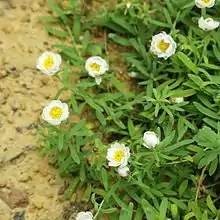Rhodanthe anthemoides
Rhodanthe anthemoides, commonly known as chamomile sunray, is a perennial species of the daisy family Asteraceae. It is endemic to Australia.[2] Plants have multiple stems rising from the base which reach up to 40 cm high and spread to 60 cm wide.[2][3][4] The leaves are about 10 mm long and 0.5 to 2 mm in width.[2]
| Rhodanthe anthemoides | |
|---|---|
 | |
| Scientific classification | |
| Kingdom: | |
| (unranked): | |
| (unranked): | |
| (unranked): | |
| Order: | |
| Family: | |
| Tribe: | |
| Genus: | |
| Species: | R. anthemoides |
| Binomial name | |
| Rhodanthe anthemoides | |
| Synonyms | |
| |
A central cluster of pale yellow flowers is surrounded by petal-like white, papery bracts. These appear between September and February in the species' native range.[3] These are followed by small dry achenes that have silky hairs.[3]
The species occurs in Queensland, New South Wales, Victoria and Tasmania.[2] Although a widespread species on the mainland, in Tasmania it is listed as "rare" under the TSP Act. It is found in mountainous regions growing in sandy soil.[2]
Cultivation
The species is commonly cultivated, preferring a well drained, lightly shaded situation. Cutting back after flowering prevents plants from becoming straggly.[4] Plants are well suited to being grown in containers.
Propagation is from seed or cuttings, named cultivars requiring the latter method to be true to type.[4]
Cultivars include:
References
- "Rhodanthe anthemoides". Australian Plant Name Index (APNI), IBIS database. Centre for Plant Biodiversity Research, Australian Government, Canberra. Retrieved 6 April 2011.
- Wilson, Peter G. "Rhodanthe anthemoides". PlantNET - New South Wales Flora Online. Royal Botanic Gardens & Domain Trust, Sydney Australia. Retrieved 6 April 2011.
- "Rhodanthe anthemoides" (PDF). Threatened Flora of Tasmania. Department of Primary Industries. Retrieved 6 April 2011.
- "Rhodanthe anthemoides". Australian Plants Society (Australia). Retrieved 6 April 2011.